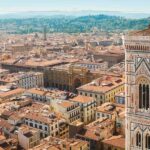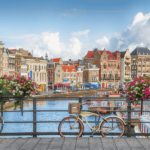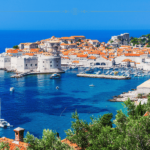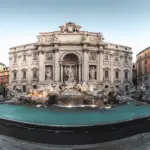Italian authorities have implemented sweeping new regulations targeting tourist behavior across the country’s most popular destinations. The comprehensive crackdown reflects growing frustration with overtourism and its impact on cultural heritage sites, historic infrastructure, and local communities. These measures, backed by substantial financial penalties, mark a decisive shift toward stricter tourism management as Italy seeks to balance economic benefits with preservation priorities.
The new enforcement wave comes as Italy grapples with record-breaking visitor numbers that have strained resources in cities like Rome, Venice, and Florence. Local governments have coordinated their efforts to create a unified approach to tourist behavior management, establishing clear boundaries for activities that were previously tolerated but are now recognized as problematic.
1. Swimming in Venice’s Canal Network Faces Severe Penalties

Venice has declared swimming in its historic waterways completely illegal, with violators facing fines between 350 and 500 euros. The city’s canal system, which serves as both a transportation network and sewage system, poses serious health risks to swimmers while creating dangerous conflicts with water traffic.
The enforcement became necessary after numerous incidents involving tourists diving into canals near popular attractions like the Rialto Bridge and St. Mark’s Square. Municipal authorities report that the polluted water contains bacteria levels far exceeding safe swimming standards, while the constant boat traffic creates life-threatening situations for unauthorized swimmers.
Beyond safety concerns, officials emphasize that swimming in the canals shows profound disrespect for Venice’s unique urban environment. The city’s delicate ecosystem depends on maintaining proper water flow and quality, making human contamination a serious environmental threat that requires aggressive intervention.
2. Drone Operations Without Permits Draw Heavy Fines
Unauthorized drone flights across Italy now carry minimum fines of 500 euros, with penalties escalating rapidly for violations near sensitive locations. The regulation addresses widespread concerns about privacy violations, security risks, and interference with aviation safety around the country’s numerous airports and helicopter routes.
Rome, Florence, and Venice have established comprehensive no-fly zones covering their historic centers, where drone operations can interfere with emergency services and create safety hazards in crowded tourist areas. The Italian Civil Aviation Authority has coordinated with local police forces to enforce these restrictions through sophisticated detection equipment and regular patrols.
Tourism industry representatives acknowledge that while drones can capture spectacular footage of Italy’s landmarks, the technology’s misuse has created genuine problems for residents and other visitors. Professional photographers and videographers can still obtain permits through established procedures, but casual recreational use has become heavily restricted.
3. Taking Natural Materials from Sardinian Beaches Triggers Massive Penalties
Sardinia has implemented Italy’s most severe tourist-related fines, imposing penalties up to 3,000 euros for removing sand, shells, rocks, or other natural materials from the island’s beaches. The regulation addresses a persistent problem where millions of visitors annually collect seemingly harmless souvenirs that collectively represent significant environmental damage.
Scientific studies have documented measurable changes to Sardinian beaches caused by souvenir collection, with some areas losing substantial amounts of sand and unique geological formations. The island’s distinctive pink and white sand beaches face particular pressure from tourists seeking unusual specimens for personal collections.
Airport security now actively screens departing passengers for natural materials, with customs officials empowered to impose immediate fines and confiscate illegal souvenirs. The enforcement program has generated significant revenue for conservation efforts while dramatically reducing the volume of materials being removed from protected coastal areas.
4. Sitting on Rome’s Spanish Steps Results in Immediate Fines
Rome’s iconic Spanish Steps are now completely off-limits to sitting, with violations carrying penalties up to 400 euros. The restriction protects the 18th-century marble staircase from damage caused by millions of tourists annually using the steps as impromptu seating areas.
Archaeological assessments revealed that constant human contact was causing micro-fractures and accelerated weathering of the historic stonework. The cumulative weight and movement of tourists created stress patterns that threatened the structural integrity of this UNESCO World Heritage site.
Enforcement officers now patrol the area continuously during daylight hours, issuing warnings and fines to visitors who attempt to sit on the steps. Alternative seating areas have been established nearby, but the Spanish Steps themselves remain strictly for transit purposes only.
5. Flip-Flop Hiking in Cinque Terre Faces Dramatic Fine Range
The Cinque Terre National Park has banned inappropriate footwear on its famous coastal hiking trails, with fines ranging from 50 to 2,500 euros depending on circumstances. The dramatic penalty range reflects the varying costs associated with rescue operations when tourists wearing flip-flops or other unsuitable shoes require emergency assistance.
Park officials report that inadequate footwear contributes to approximately 40 percent of hiking-related injuries along the challenging coastal paths. The steep, often slippery terrain demands proper hiking boots or athletic shoes with sufficient traction and ankle support.
Emergency response teams have lobbied for these restrictions after experiencing dangerous rescue situations where both tourists and rescue personnel faced unnecessary risks due to preventable footwear-related accidents. The higher fines apply when inappropriate footwear contributes to complex rescue operations requiring helicopter evacuation or technical climbing equipment.
6. Feeding Pigeons in Venice Draws Substantial Penalties
Venice has banned pigeon feeding throughout the city center, with particular enforcement around St. Mark’s Square where fines can reach 500 euros. The restriction addresses serious damage to historic buildings caused by increased pigeon populations attracted by tourist feeding activities.
Architectural conservation experts have documented extensive damage to marble facades, bronze sculptures, and decorative elements caused by pigeon droppings and nesting activities. The acidic nature of bird waste accelerates deterioration of priceless artistic works, creating restoration costs that far exceed tourism revenue.
Public health concerns also support the feeding ban, as large pigeon populations create sanitation problems and increase disease transmission risks in crowded tourist areas. The city has implemented comprehensive pigeon population management programs while educating visitors about the environmental consequences of feeding wildlife.
7. Climbing Trees in Roman Parks Incurs 100-Euro Penalties
Rome’s municipal parks have banned tree climbing entirely, imposing fines up to 100 euros for violations. The restriction addresses both safety concerns for tourists and protection of urban forest ecosystems that provide crucial environmental benefits in the densely populated city.
Park management studies revealed that tree climbing causes significant damage to bark and branch systems, making trees more susceptible to disease and weather damage. The cumulative impact of thousands of climbing incidents annually threatened the health of Rome’s historic park trees, some of which are centuries old.
Insurance liability concerns also motivated the ban, as tree-climbing injuries create substantial costs for municipal authorities. Professional arborists emphasize that urban trees face unique stresses from pollution and limited growing space, making them more fragile than their natural forest counterparts.
8. Noisy Footwear on Capri Disturbs Island Tranquility
The island of Capri has implemented noise restrictions targeting footwear, with fines up to 100 euros for shoes that create excessive sound on the island’s characteristic stone streets and walkways. The regulation prioritizes the peaceful atmosphere that attracts high-end tourists seeking tranquil Mediterranean experiences.
Local residents complained that the constant clicking and clattering of inappropriate footwear created persistent noise pollution throughout the island’s narrow streets and residential areas. The problem intensified during peak tourist seasons when thousands of daily visitors wearing hard-soled shoes or noisy sandals generated continuous disturbances.
The enforcement focuses on wooden clogs, metal-studded footwear, and hard plastic sandals that create the most disruptive sounds on stone surfaces. Visitors can avoid penalties by choosing appropriate soft-soled shoes that respect the island’s acoustic environment.
9. Jumping in Public Fountains Triggers Disrespect Penalties
Historic fountains throughout Italy are now protected by regulations prohibiting jumping, bathing, or any form of unauthorized water contact, with fines reaching 450 euros. The restriction addresses both preservation concerns and cultural sensitivity issues surrounding these artistic and religious monuments.
Rome’s Trevi Fountain, the Pantheon’s fountain, and similar water features in Florence and other cities have suffered damage from tourists introducing oils, soaps, and other contaminants into their delicate filtration and circulation systems. The maintenance costs for removing human contamination far exceed the expense of regular upkeep.
Cultural heritage experts emphasize that many fountains hold religious or commemorative significance that makes recreational use deeply inappropriate. The enforcement program has successfully reduced fountain damage while educating visitors about proper behavior at sacred and historic sites.
10. Dragging Luggage Through Venice Damages Historic Infrastructure
Venice has prohibited dragging wheeled luggage across the city’s historic stone bridges and steps, with fines around 100 euros for violations. The restriction protects centuries-old Istrian stone infrastructure from damage caused by millions of annual suitcase impacts.
Engineering assessments documented measurable wear patterns on bridge surfaces and step edges directly attributable to luggage dragging. The cumulative effect of constant scraping and impact has accelerated deterioration of irreplaceable architectural elements throughout the city.
Alternative transportation services have emerged to help tourists comply with the regulation, including water taxi luggage transfers and porter services that use appropriate equipment for navigating the city’s unique pedestrian infrastructure.
11. Street Performance Without Permits Faces Standardized Penalties
Unauthorized busking and street performance across Italian cities now carries fines between 100 and 500 euros, with penalties varying based on location and circumstances. The regulation balances cultural expression with public order concerns while ensuring that performances enhance rather than obstruct the tourist experience.
Popular tourist areas in Rome, Florence, and Venice experienced overcrowding and conflicts between competing performers, creating safety hazards and noise problems for residents and visitors. The permit system establishes designated performance zones and time restrictions that prevent conflicts while maintaining vibrant street culture.
Licensed performers report improved working conditions under the new system, as designated areas and time slots eliminate competition conflicts while providing legal protection for their artistic activities. Revenue from permit fees supports cultural programs and street art initiatives throughout participating cities.
12. Public Car Washing Banned in Multiple Municipalities
Numerous Italian towns and cities have prohibited washing vehicles in public spaces, with typical fines around 100 euros for violations. The environmental regulation addresses water pollution concerns and resource conservation while directing car washing activities to facilities with proper drainage and filtration systems.
Municipal authorities identified public car washing as a significant source of chemical runoff that contaminates storm water systems and local waterways. Soap residues, oil deposits, and other automotive fluids create environmental damage that extends far beyond the immediate washing location.
Professional car wash facilities have invested in water recycling systems and chemical treatment equipment that eliminate environmental impact while providing superior cleaning results. The regulation encourages responsible resource use while supporting local businesses that comply with environmental standards.
13. Cycling in Historic City Centers Draws Increasing Penalties
Historic districts in Rome, Florence, Venice, and other Italian cities have expanded cycling restrictions, with fines exceeding 100 euros for violations in designated zones. The regulations protect both pedestrian safety and historic infrastructure from damage caused by bicycle traffic on surfaces never designed for wheeled vehicles.
Medieval streets and Renaissance piazzas face structural stress from bicycle traffic that exceeds their original design parameters. The narrow corridors and crowded conditions create dangerous conflicts between cyclists and pedestrians, particularly during peak tourist seasons.
Alternative transportation options, including expanded public transit and designated cycling routes outside historic centers, provide visitors with mobility options that respect preservation requirements while maintaining access to cultural attractions.
14. Using Soap in Beach Showers Violates Environmental Protection
Coastal municipalities across Italy have banned soap use in beach shower facilities, with fines reaching 300 euros for violations. The environmental regulation protects marine ecosystems from chemical contamination that occurs when soap residues enter coastal waters.
Marine biologists have documented significant ecological damage in areas where beach showers discharge soap-contaminated water directly into the sea. Chemical ingredients in personal care products create algae blooms and disrupt the reproductive cycles of marine organisms essential to coastal ecosystem health.
Beach facilities now provide signage in multiple languages explaining the environmental rationale for soap restrictions, while encouraging visitors to use biodegradable products at appropriate distances from water sources.
15. Picnicking on Historic Monuments Shows Cultural Disrespect
Archaeological sites and historic monuments throughout Italy have banned picnicking activities, with fines up to 250 euros for violations. The restriction addresses both preservation concerns and cultural sensitivity issues surrounding sites that hold deep historical and spiritual significance.
Food and beverage consumption near historic stonework introduces acids, oils, and other substances that accelerate deterioration of irreplaceable cultural artifacts. Spilled drinks and food waste also create maintenance challenges while attracting pests that can damage ancient structures.
Cultural heritage educators emphasize that many monuments serve as memorials or sacred sites where recreational activities are profoundly inappropriate. The enforcement program combines penalties with educational outreach that helps visitors understand the cultural significance of Italy’s archaeological treasures.
Implementation and Enforcement Strategies
Italian authorities have coordinated enforcement efforts across multiple levels of government, from municipal police to national heritage protection agencies. The comprehensive approach ensures consistent application of regulations while providing clear communication to international visitors about expected behavior standards.
Tourism industry representatives have generally supported the regulatory framework, recognizing that preservation efforts protect the cultural assets that attract visitors to Italy. Professional tour guides now incorporate regulation awareness into their standard presentations, helping tourists understand both the rules and the reasoning behind them.
The financial penalties serve multiple purposes beyond simple deterrence, generating revenue for conservation efforts while creating meaningful consequences for behavior that threatens Italy’s cultural heritage. Early enforcement data suggests that awareness and compliance rates have improved significantly as visitors become familiar with the new regulatory landscape.
These fifteen regulations represent Italy’s commitment to sustainable tourism practices that balance economic benefits with long-term preservation goals. The comprehensive approach addresses decades of accumulated damage while establishing clear expectations for responsible visitor behavior in one of the world’s most culturally significant destinations.




